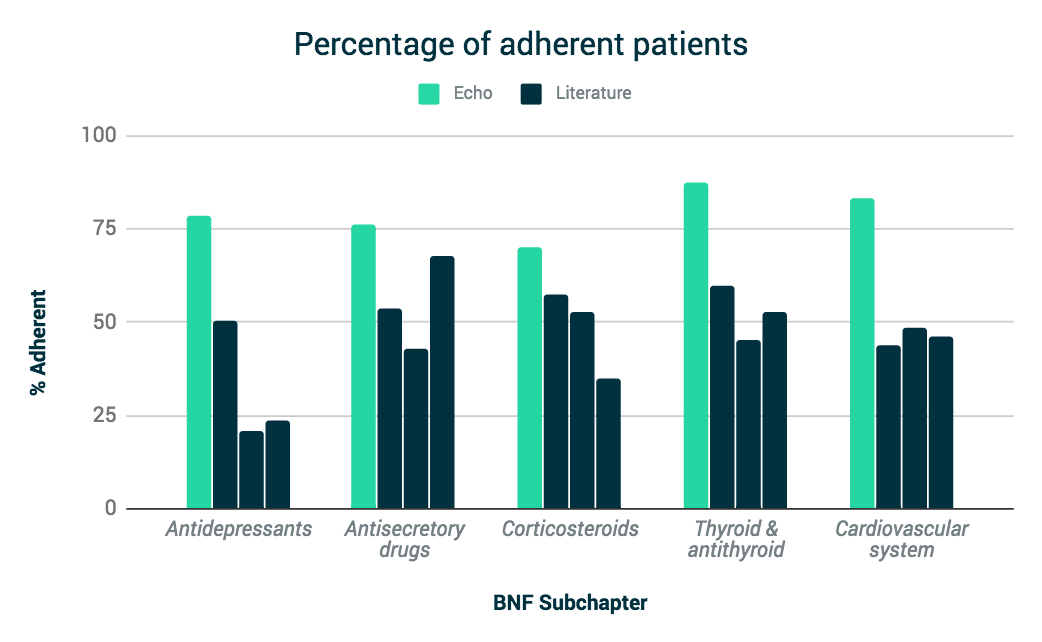What we know (and don’t know) about LloydsDirect’s impact on medicines adherence
First published - September 2018

Over the summer we decided to figure out what, if any, impact LloydsDirect (formerly Echo) has on medicines adherence. I’m going to try and summarise our findings in plain English.
For the uninitiated, NICE claims about a third and half of all medicine isn’t taken as directed, and the WHO estimates adherence rates to be around 50%. We spend over £17bn a year on medicine in England alone, so this is a big problem.
Now, if people don’t take their meds properly you get waste – notably, the cost of the drugs and the clinician’s time. But the real issue is that non-adherence leads to poorer outcomes. People get sick and end up in hospital, where costs quickly escalate.
So why don’t people take their meds? There are lots of reasons, from not liking the side effects to not understanding why they’ve been prescribed the stuff in the first place. A lot of people we talk to simply forget to either take their meds or reorder at the end of the month. Others find running the GP/pharmacy gauntlet a headache.
We started LloydsDirect to solve these problems, so is it working?
Measuring adherence is tricky because it involves getting patients to do stuff, and even the most motivated subject will lose interest after a few months. So instead we looked at actual orders delivered, over a period of time, to see if patients were adherent. This methodology is far from perfect – just because patients order meds doesn’t mean they are actually taking then. But it’s a fairly standard metric and a good place to start.
Other issues with our methodology include selection bias and that we only looked at orders placed on the LloydsDirect platform – if patients got a prescription filled elsewhere it doesn’t count. This means we looked at LloydsDirect order to order cycles, not say, twelve months in the life of a patient. I’m flagging these points to make it clear that we need to do a lot more work, this is just a start. But the results are encouraging.
Key findings:
Over 75% of LloydsDirect users are adherent; and across all meds, adherence was 88%. Women are slightly more adherent than men, older patients are much more adherent than younger patients, and the more meds a patient takes the more likely they are to be adherent.
Here are some tables of how adherence breaks down by patient category:
| Gender | Adherence |
|---|---|
| Female | 76.89% |
| Male | 73.03% |
| Exemptions | Adherence |
|---|---|
| Clinical | 80.25% |
| Pre-payment | 76.50% |
| Economic | 72.03% |
| Not exempt | 65.76% |
| Age | Adherence |
|---|---|
| 18-24 | 71.44% |
| 25-34 | 72.44% |
| 35-44 | 75.80% |
| 45-54 | 75.05% |
| 55-64 | 81.15% |
| 65+ | 86.32% |
| Number of medicines | Adherence |
|---|---|
| 1 | 72.52% |
| 2 | 75.66% |
| 3 | 77.45% |
| 4 | 83.37% |
| 5 | 82.29% |
| 6+ | 83.00% |
Our sample size was 8,481 patients, and the results tally with what we would expect to see based on our clinician’s experience. So how does LloydsDirect compare with the literature? We looked at our five most popular medication categories:

Make it easier for people to get their meds and they will be more likely to get their meds. Who knew!?
You can read the full write up by following this link. Next step is independent review and submission for publication. Oh, and lots more research - if you are interested in getting involved please drop us a note at hello@lloydsdirect.co.uk .